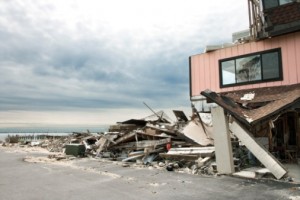 It’s been more than a year since Superstorm Sandy came ashore on the Eastern Seaboard. More than 365 days and still some families are not able to return home to begin rebuilding as they battle insurance companies and red tape. So, what’s been going on for the past year and where do we stand now?
It’s been more than a year since Superstorm Sandy came ashore on the Eastern Seaboard. More than 365 days and still some families are not able to return home to begin rebuilding as they battle insurance companies and red tape. So, what’s been going on for the past year and where do we stand now?
The National Hurricane Center reports Sandy killed an estimated 160 people in the U.S. and dozens more in the Caribbean. She came ashore on October 29, 2012, and caused billions of dollars in damage. As NBC News reports, she caused damage to some 650,000 structures, 366,000 in New York and New Jersey alone.
What’s left of her damage varies from place to place. In some areas, vacant lots remain where homes and businesses once stood. In others, damaged homes remain as owners work through various stages of repair. And some haven’t even been able to begin—still waiting on insurance claims and government money to come through.
State and local officials estimate some 27,000 households in New Jersey and New York are still displaced. The main barrier to getting home: money. While FEMA has awarded more than $1.4 billion in assistance to people in five states, the states seem to be slow to pass on the assistance.
Federal grants of $150,000 and $300,000 from the Department of Housing and Urban Development, designed to help homeowners facing shortages in rebuilding, are not reaching the people who need them in a timely manner.
Of $600 million in HUD funds, the state of New Jersey has distributed $3 million, according to an earlier report from NBC. Thousands of families who need this money to rebuild or make do in the meantime are left without permanent homes.
Many survivors, waiting for any kind of help, have given up on receiving grant money. Instead, they’ve opted to use what little money they have and hope for the best.
Officials say that much of the delay results from federally-mandated hoops that homeowners must jump through before gaining access to funds. These hoops are in place to prevent fraud but result in unnecessary frustrations for the families who have nothing more than rebuilding their lives in mind.
The losses from the storm were staggering. And while rebuilding can’t be expected to happen overnight, red tape and reluctance on the part of government officials and insurance companies seem to be holding things up more than necessary.
Some takeaways from the infographic:
- Sandy is the 2nd costliest hurricane in the U.S. since 1900, with total damage estimated at $50 billion or more.
- The storm destroyed 305,000 housing units in New York and 346,000 in New Jersey.
- FEMA has only inspected an estimated 160,000 of these homes.
Moving Forward
After Sandy, things will change for home and business owners across the area, as flood maps are updated to reflect those in at-risk areas. This will raise insurance rates, among other changes.
For now, some are calling the response to Sandy a failure.
The litmus test of any disaster relief plan, according to Marc Roy, who was the chief of staff for FEMA’s Louisiana operations after Hurricane Katrina, is that the money gets to the people who need it. In the case of Sandy, that simply hasn’t happened enough.
In a recent survey of New Jersey residents, 75 percent of respondents said they feel they have been forgotten in the recovery effort.
The money is there, it is earmarked for the people who need it the most, but it isn’t being delivered.
